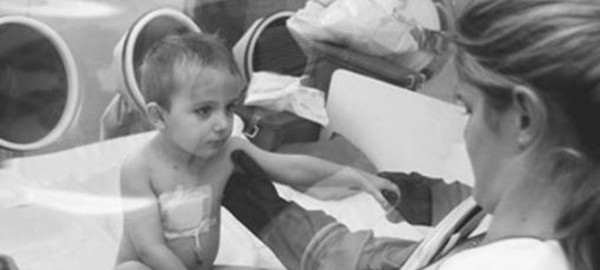New Gene Therapy May Help Bubble Boy Disease

An early-phase trial has demonstrated that gene therapy may help Bubble Boys, a term that became famous in the 1970s and 1980s after David Vetter, a Houston boy with severe combined immunodeficiency disease (SCID), lived in a germ-free plastic bubble for 12 years. David was put in a plastic isolation unit immediately after birth because his brother had died of the disease. He lived as a “Bubble Boy” his entire life before finally succumbing to SCID in 1984. The 1976 movie The Boy in the Plastic Bubble brought the disease into the spotlight.
The most common form of SCID is a devastating X-linked inherited disorder. About 40 to 100 babies are diagnosed with the condition in the United States every year. A mutated IL2RG gene leaves these boys with a severe defect in the immune system, crippling their body’s defense against infections. In addition to suffering from one or more life-threatening infections in the first few months of life, Bubble Boys are also prone to becoming ill from routine immunization. The weakened viruses and bacteria in vaccines (which don’t harm healthy children) can lead to severe infections in those with SCID. The disease is often fatal within the first two years of life.
A small trial conducted on five boys at the St. Jude Children’s Research Hospital in Memphis, Tennessee, has assessed if safe and effective gene therapy can help those with SCID. The study was conducted in collaboration with the U.S. National Institute of Allergy and Infectious Diseases. The boys, ranging in age from 7 to 23, had failed to respond to bone marrow transplants to correct their immune deficiency.
The treatment employed gene therapy with lentivirus and busulfan conditioning to fix the immune system, says Dr. Brian Sorrentino, senior study author and Director of the Experimental Hematology Division at St. Jude. Lentivirus (lente is Latin for slow) is a genus of viruses with a characteristically prolonged incubation period, making them particularly useful as vectors for the insertion, modification, and deletion of genes in host cells. When combined with the chemotherapy drug busulfan, lentivirus can be used to provide broader immunity to young adults with SCID. In this study, the researchers re-engineered the lentivirus and used it to deliver corrected copies of the mutant gene to stem cells in the bone marrow of these patients.
Another successful treatment has been reported in the New England Journal of Medicine, where gene therapy seems to have cured 8 out of 10 children with Bubble Boy disease. This type of SCID occurs in both boys and girls and causes deficiency of the enzyme adenosine deaminase. Researchers in Israel and Italy removed marrow cells from these patients, equipped them with working copies of the gene to produce the enzyme, and re-injected the cells back into the marrow. When followed four years later, 8 of the 10 patients did not need further treatment with enzyme injections.
While additional research and clinical followup are needed, the preliminary results are promising. Now scientists must try to understand why there is a leukemia risk associated with gene therapy for the most common form of SCID, but not the enzyme deficiency form.
References:
https://www.nlm.nih.gov/medlineplus/news/fullstory_158415.html
http://abcnews.go.com/Technology/story?id=6790119&page=1
https://en.wikipedia.org/wiki/Lentiviral_vector_in_gene_therapy
Image courtesy of http://images.hngn.com/


